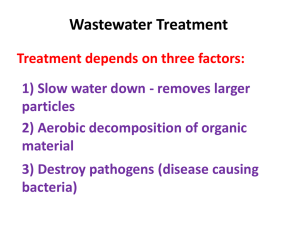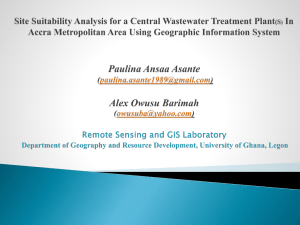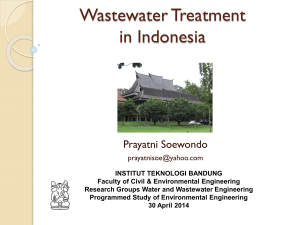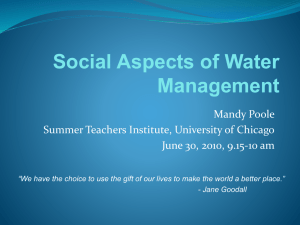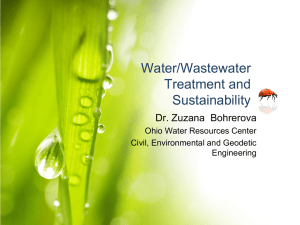8. Wastewater Management and Reuse in Islamabad
advertisement
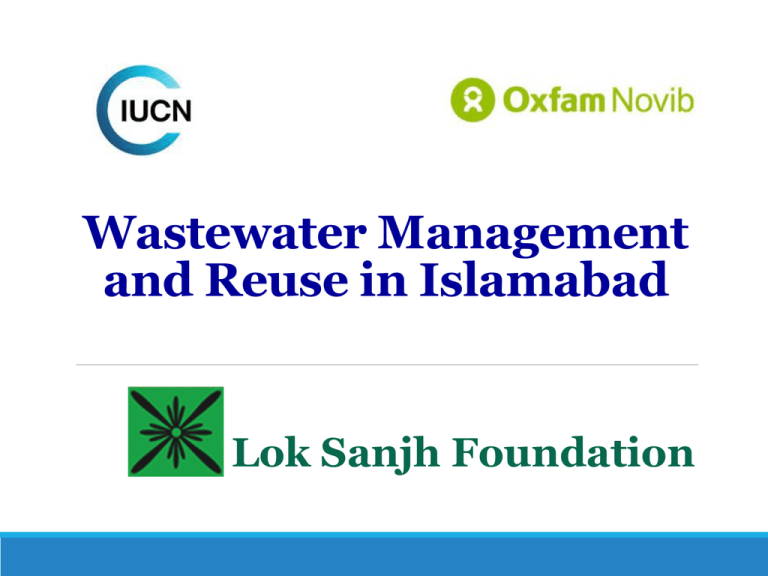
Wastewater Management and Reuse in Islamabad Lok Sanjh Foundation Background Islamabad Capital Territory 25 storm water streams flowing through the Islamabad Capital Territory (ICT). Finally converge into two large streams outside the ICT area controlled by the province of Punjab. Management of urban wastewater poses a serious challenge for the storm water streams flowing through the ICT. Wastewater Challenges in ICT The large quantities of storm water that flows out as waste from the urban settlements into the natural fresh water streams are: Now polluted with sewage, and Solid wastes especially in the dry season All the pollutants drains into the tributaries leading to Soan and Korang rivers. These streams also provide an ideal environment for the breeding of mosquitoes due to the addition of sewage and solid wastes. These streams also recharges the shallow groundwater and as a result, the quality of groundwater around these streams is extremely poor in terms of bacterial parameters. Pictorial View of Wastewater Challenges (Sewerage System) Pictorial View of Wastewater Challenges (Sewerage System) Pictorial View of Wastewater Challenges (Solid Waste) Pictorial View of Wastewater Challenges (Solid Waste) Pictorial View of Wastewater Challenges (Solid Waste) Pictorial View of Wastewater Challenges (Solid Waste) Pictorial View of Wastewater Challenges (Solid Waste) Pictorial View of Wastewater Challenges (Solid Waste) Pilot Stream 2 Minute Short Video Presentation Freshwater stream originate from the “Ficus Spring“ of Margala Hills in Trail # 5. After crossing the Margalla Road, it enters into urban areas G/5, Marriot hotel, G-6/3 and F-6/4. Further, flowing back of Lal Masjid and Friday bazar it crosses over Kashmir highway near Abpara Chowk. Then enters in to the Rose and Jasmine Garden, where it merges into another stream. It continues flowing on back side of the Sports Complex and crosses the Murree road at Faizabad intersection, finally falling in to the Korang River. Diagnostic Surveys and Analysis An integrated approach to the field investigations was employed in the pilot study. The practices of solid waste disposal on the banks of targeted stream in Islamabad metropolis were examined. The water quality of the wastewater stream was monitored at various locations where sewage water was being disposed. Solid water disposal sites were monitored in order to evaluate interactions and assess the possibility of stream water contamination. Soil and water sampling; and laboratory-based experimental and instrumental analyses were carried out. Diagnostic Surveys and Analysis Practical Interventions introduced in the Pilot Study 1. Campaigns were organized to create awareness among the wastewater users at the tail-end sections. 2. A Wastewater Users’ Organization was established in the Sohan Village. 3. Farmers were trained through demonstrations for organic compost making with the help of EM technology at the selected farms. 4. The EM solution of 1:100 ratio (EM:Water) was prepared for spray on the solid waste especially the animal dung locally available in large quantities. Practical Interventions introduced in the Pilot Study 5. The EM propagation facility has been developed at different levels. The main facility is developed using a PE tank of 500 gallons capacity. 6. Propagation facility was developed at ten selected sites where ceramic containers are used to develop larger amount of extended EM at the selected locations starting from CDA nursery at Trail #5 to provide enough time to enhance the critical mass of micro-organisms. What is EM Technology ? E.M. is an abbreviation for Effective Microorganisms: Microorganisms are tiny units of life that are too small to be seen with the naked eye and they exist everywhere in nature. Microorganisms are crucial for maintaining the ecological balance. They carry out chemical processes that make it possible for all other organisms including humans to live. There are friendly guys of the microbial worlds known as beneficial microorganisms and a not so friendly group called pathogens that are harmful and capable of producing disease, decay and pollution. EM origin: In 1982 Dr.Higa at the University of Ryukyus, Okinawa Japan, discovered a specific group of naturally occurring beneficial microorganisms Practical Interventions: Organic Compost Making With EM Practical Interventions: EM Propagation Practical Interventions: Domestic Use of EM Trainings of female were conducted and 250 bottles (1.5 liter each) of EM were distributed for usage in the toilets and compost making from kitchen waste. Follow-up reporting was very encouraging. The use of EM in toilets not only controlled the bad odour but also started bacterial activity with the sewage and thus travel time is increased. Practical Interventions: EM Application to Vegetables and Wheat Crop o Water tanks and EM solution were provided to the participating famers free of cost and farmers reported improved health of plants. Practical Interventions: Aquatic Plants for Treatment of Wastewater o Treatment systems using aquatic plants consist of shallow waters containing floating or submerged aquatic plants. o The water lettuce was used in the stream which remained floating distinguished by their ability to meet their need for carbon dioxide and oxygen. o Water pennywort plants were also used because they have the ability to grow around the wastewater by absorbing oxygen, carbon dioxide, and minerals directly from the wastewater and clean the water. Aquatic Plants for Treatment of Wastewater Water Lettuce Pennywort Oxidation by Using Small Stones Oxidation of wastewater through creating turbulence by using small stones has been applied as a possible solution near the Faizabad Chowk. This is being replicated at various points along the targeted stream. Research Based Findings o Wastewater samples were taken from 14 points from Trail #5 to the end point, where this stream joins the Korang River. o All the points from the tail end were sampled where farmers were pumping wastewater from the stream. o The water samples analysis included physical and biological/bacteriological parameters (EC, pH, Turbidity), major chemical parameters (Carbonate & TDS) were tested along with wastewater parameters, BOD (organic contamination), COD, dissolved oxygen and total suspended solids. Total coliforms, fecal coliforms and e. coli were detected positive in all the 14 samples and all the samples were microbiologically contaminated and unfit. Research Based Findings As for as fertility status of soils is concerned, available phosphorus ranged from 1.9 - 35.2 ppm which indicates that soils of head portion are weak in phosphorus as compared with tail-end soils with high content of phosphorus which is good for crops. Organic matter percentage less than 0.86% is considered poor and soil tests shows that organic matter ranged between 0.15 and 0.63 percent which is less than the limit of 0.86%. Policy Implications There is no framework available with the federal government (e.g. CDA) for the use of wastewater polluted with sewage and thus effective regulations are needed. As most of channels flow back and forth within ICT and provincially administered areas of Punjab, therefore regulations are need both at the federal and provincial levels. Currently, there is no monitoring system enforced either by CDA or the federal EPA to regulate the disposal of domestic and industrial effluents in to the fresh water streams. In the ICT area the sole responsibility lies with the Thank you!


